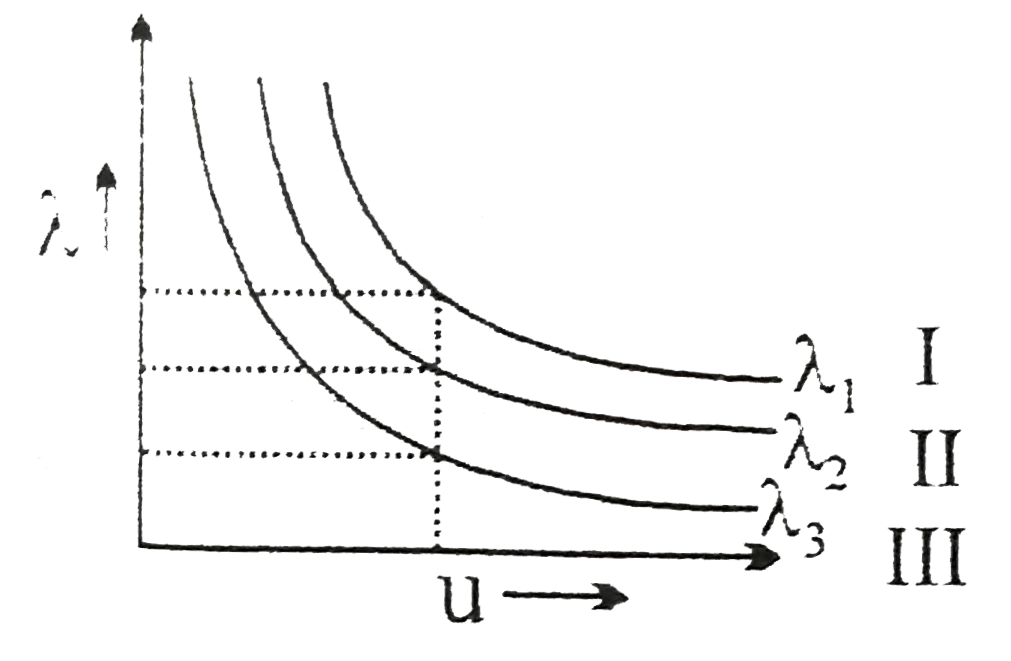For electron, proton , deuterium molecule(D2) & α- particule a curve between λ(De Broglie wavelenght ) v/s u (speed) is plotted. Selected the correct satatement (s).

Curve I is for electrons
Curve III is for photon
Curve II is for α-particle
Curve III is for Deuterium(D2)
The correct Answer is:A, D

At a particular veloocity
λα1m, mα>mD2>mp>me, λα<λD2<λp<λe
Topper's Solved these Questions
- ATOMIC STRUCTUREBook:BANSALChapter:ATOMIC STRUCTUREExercise:MATCH THE COLUMN
Explore 10 Videos
- ATOMIC STRUCTUREBook:BANSALChapter:ATOMIC STRUCTUREExercise:Exercise.3
Explore 35 Videos
- ATOMIC STRUCTUREBook:BANSALChapter:ATOMIC STRUCTUREExercise:REASONING TYPE
Explore 10 Videos
- GENERAL ORGANIC CHEMISTRYBook:BANSALChapter:GENERAL ORGANIC CHEMISTRYExercise:Exercise 3
Explore 9 Videos
Similar Questions
Knowledge Check
Select the correct statement(s) regarding BF2NH2 molecule:
AFBF bond angle <120∘BHNH bond angle >109∘28'CHNH bond angle <109∘28'DFBF bond angle >120∘Select the correct statement(s) regarding BF2NH2 molecule:
AFBF bond angle <120∘BHNH bond angle >109∘28'CHNH bond angle <109∘28'DFBF bond angle >120∘An electron, a neutron and an alpha particle have same kinetic energy and their de-Broglie wavelength are λe,λnandλα respectively. Which statement is correct about their de-Broglie wavelengths?
Aλe>λn>λαBλe<λn>λαCλe<λn<λαDλe>λn<λα
An electron of mass m when accelerated through a potential difference V, has de Broglie wavelength λ. The de Broglie wavelength associated with a proton of mass M accelerated through the same potential difference, will be :-
View Solution(i) Show that the de-Broglie's wavelength of electrons accelerated through a potential V volts can be expressed as
λ=h√meV.
What is the de-Broglie wavelength of a 2kg object moving with a speed of 1ms−1 ?
(ii) Calculate the ratio of the accelerating potential required to accelerate (i) a proton and (ii) an α particle to have the same de-Broglie wavelength associated with them.
[Given: mass of proton =1.6×10−27kg. Mass of α-particle=6.4×10−27kg].
View Solution(b) Calculate de Broglie wavelength for an electron moving with a speed of 106 m s−1.
View SolutionAn electron of mass 'm', when accelerated through a potential V has de-Broglie wavelength λ. The de-Broglie wavelength associated with a proton of mass M accelerated through the same potential difference will be:
View SolutionAn electron of mass m when accelerated through a potential difference V has de - Broglie wavelength λ. The de - Broglie wavelength associated with a proton of mass M accelerated through the same potential difference will be
View Solution

